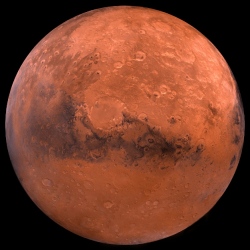
NASA’s goal is to put the first boot prints on Mars in the 2030s. There’s a lot of work to be done before then, and many small steps to take in between. The space agency has come under fire for not thoroughly plotting its roadmap to Mars. Lockheed Martin wants to help fill in the details.
The company is responsible for building the Orion spaceship that will carry NASA astronauts to Mars, and it’s also hoping NASA will sign on to its Mars Base Camp proposal.
Mars Base Camp could let astronauts control robots on the Martian surface in real time. The Base Camp would be a Lockheed Martin-built laboratory that orbits Mars, giving astronauts the ability to drive rovers and UAVs on the Martian surface in real-time, and perhaps paving the way for a landing party. The proposed laboratory could be on in orbit around Mars by as soon as 2028, the company says.
NASA’s Orion spacecraft will travel thousands of miles beyond the moon in 2018
An uncrewed Orion capsule will ride into space on the first launch of the Space Launch System–NASA’s mega-sized, deep-space exploring rocket–in 2018. If all goes as planned, the capsule will travel thousands of miles beyond the moon, going farther than any human-rated spacecraft has gone before. Orion will orbit the moon during its three-week mission before returning to Earth. Data gathered during this test flight will help to inform future crewed missions, first to lunar space and then, some day, Mars.
2021: Begin Building Base Camp
Astronauts could help put together the Mars Base Camp in orbit around the moon. NASA’s current plan for 2021 is to launch a spacecraft toward a nearby asteroid to pick up a boulder and bring it back into orbit around the moon. The Asteroid Redirect Mission (ARM) is not exactly well-loved, but it would serve as a way to test out some futuristic ion engines that could slowly but efficiently carry our luggage to Mars.
Lockheed Martin’s proposal for 2021 is to start building the Mars Base Camp in cis-lunar space–the area between Earth and the Moon.
According to Lockheed’s plan, this would entail the first crewed flights of Orion and SLS. NASA had originally planned to fly astronauts by 2021, but that deadline slipped to 2023.
Building the Mars Base Camp could also serve as a way to test out the fancy solar electric ion drive that ARM would use.
2022: Launch A Laser-Toting Satellite To Mars. Lockheed Martin
A concept for a Mars-orbiting satellite that relays messages between Earth and Mars using broadband laser transmissions. A proposed Mars orbiter could provide the first broadband communications between Earth and Mars, using lasers. The faster speeds and larger capacity of laser transmissions could prove vital during human missions to Mars.
2024: Test Drive On The Moon
Before the Base Camp heads to Mars, astronauts could test out all the systems by operating robots on the surface of the moon.
In orbit around the moon, Base Camp allows astronauts to control robots on the lunar surface in real time, as well as collect samples that launch up to the laboratory for analysis. Or, Lockheed suggests, the astronauts could use robots to remotely set up a radio telescope on the far side of the moon. Since the lunar far side constantly faces away from Earth, it is shielded from the radio noise of humanity, which could make it a prime location for studying the stars, black holes, and more.
This practice session would help to train the astronauts on their jobs from Mars orbit, as well as work out any kinks in the systems.
2025: Visit An Asteroid
Whereas the Asteroid Redirect Mission would collect a boulder from an asteroid, and then bring it into lunar orbit for astronauts to explore in 2026, Lockheed wants to send the astronauts straight to the asteroid. This long-duration science mission would serve as a test run for Mars missions, which could last for years. It will also give astronauts a chance to leave the spacecraft and interact with a low gravity object, says Lockheed.
2026: Send Base Camp To Mars, Make Sure Everything Works
2028: Send Humans To Base Camp, Become Interplanetary Species. Landing on the surface would come later, in the 2030s.
NASA’s current outline would put the first humans on Mars in 2035, but it includes a very large leap between exploring a boulder in lunar orbit and then landing on Mars. Landing will be one of the most technologically difficult parts of the journey. Many folks have suggested orbiting Mars first, before sending a separate mission to land there. That could be in the form of an orbiting laboratory, like the Mars Base Camp, or by settling down first on one of Mars’ moons. Other pathways would test Mars-bound technologies on the surface of Earth’s moon. Each strategy has its own advantages and disadvantages.
For it’s part, Lockheed isn’t saying exactly how much Base Camp would cost. The concept "leverages existing investments in SLS and Orion, and is designed to fit within NASA’s projected exploration budgets," says a public relations officer.
Whichever pathway NASA chooses to take, it’d best decide soon. If SpaceX’s Elon Musk has his way, humans might be walking on Mars by 2026.
